


Why is heat transfer important to XMM?
Conduction, convection and radiation are the three ways in which heat is transferred from one place to another.
On the global scale they are responsible for the movement of vast amounts of energy via the weather systems and ocean currents and hence control the temperatures of the different regions round the world. These temperatures very much influence our lives and the way we live. All the modes of transport come into play in that thin layer of atmosphere above the Earth that we live in. Unfortunately (or otherwise) we cannot control these modes of heat transport at this level though we can at the much smaller scale within our homes
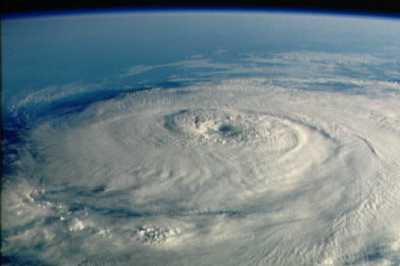
Hurricane Elana, taken from the Space Shuttle in September 1985
For satellites in space the conduction and radiation heat transport mechanisms are also very important in determining the magnitude of the temperatures and temperature distribution so that the equipment can be operated successfully as specified. In space we can control the temperatures and this is the subject of thermal design. It plays a vital role in the overall spacecraft design, and XMM is no exception.
One particular sub-system on XMM where it is extremely important to control the flow of heat is the multiple stage cooling radiators by which the CCDs are cooled to low temperatures. This is only possible by diverting the parasitic heat away from the cooled system and dumped into space.
![]()
What is conduction?
If we take a bar of metal and put energy into one end of it by heating it, after a short while the other end will also heat up; that is energy has been transported from one end to the other. If we did the same with wood instead of the metal the effect would be far less pronounced. This is because the thermal conductivity of metal is much greater than wood and is also why saucepans often have wooden handles to prevent our burning our hands. The conductivity is a physical property of the material and is a measure of its ability to conduct heat.
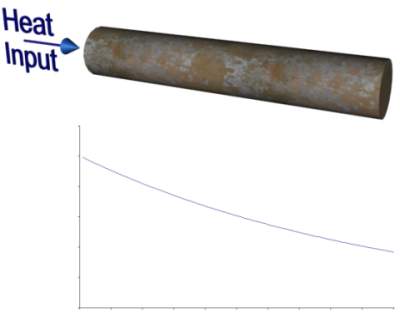
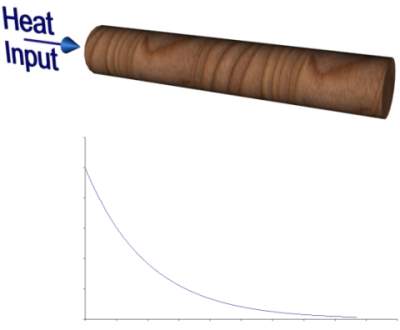
The thermal conductivity of metal is much greater then for wood. If the temperature is plotted against length, it will fall more rapidly for wood than for metal.
There are many respects in which the thermal conduction of heat is similar to the conduction of electricity (and indeed of the flow of fluid through a pipe, though this is not strictly conduction); click here for more.
You may have come across an electrified fence in the country which is used to confine cattle to prescribed grazing areas and wondered if the wire is active or not and safe to touch. One way of doing this is to select a long, thin piece of dry grass, one end of which you hold and the other you place on the wire. If the fence is active you feel a tingling which will increase as you move the contact point of the grass with the wire closer to your hand. In both cases, common sense tells us that the amount of heat (electricity) being conducted increases if we either reduce the cross section of the material or its length . Make sure the grass is thin and not wet otherwise you may get a shock.
![]()
How does conduction work?
Conduction is the result of collisions between the particles making up the material. The particles have some motion as a result of there being at some temperature and therefore have kinetic energy and momentum. During a collision energy and momentum can be exchanged and therefore transferred from one particle to another. Wherever a temperature gradient exists a net flow of heat will result.
Imagine a number of stationary goods trucks which are coupled to each other and constrained to movement in one dimension by the railway lines on which they can roll. Applying an impulsive force to the truck at one end causes it to hit the adjacent truck and bounce back as a result of the buffers imparting some energy and momentum as it does so. In this way the motion is passed on from truck to truck and eventually imparted to the truck at the other end where the motion (energy) could be extracted to do something useful.
Clearly particles are not constrained in such a way, though the degree of constraint can vary depending on the state of the matter but the principle is the same. Also the effectiveness depends on the efficiency of passing on the energy during the collision process.
![]()
How effective is conduction?
We can always make conduction more effective by making it operate over as short a distance and over as large an area as possible. Choosing a material with a large thermal conductivity also increases the effectiveness. We should remember that the conductivities can depend on temperature and, in the case of a gas, on the pressure.
In terms of the effectiveness compared with the other modes of heat transfer this very much depends on the physical circumstances.
![]()
What is the radiative transfer of energy?
Here radiation means electromagnetic radiation whether it is visible light or X-ray light or whatever and covers all the frequencies of the spectrum from the very low (radio waves) to the very high (gamma rays). We can describe light in terms of photons which are packets of light. We can think of them as light particles in so far as they have some of the characteristics of particles but they are not particles as atoms are. For example photons cannot collide one with another. But they do carry both energy and momentum. They carry momentum by virtue of having an effective mass. However the energy they carry is not a result of their motion (they all move at the velocity of light) but of their frequency; the energy carried by a photon is proportional to its frequency.
Although photons cannot collide with one another they can collide with ordinary matter. For example, a photon can collide with an electron in an atom and cause it to go into an excited state by absorbing the energy of the photon. The electron can then relax into its original state by emitting a photon to which is passed all or some of the energy of the absorbed photon. Thus energy and momentum can be transferred by the good offices of the third party (the matter), in this case the electron bound to the atomic nucleus. Electrons are effective in this role and free electrons are even more effective than the bound ones (they are not governed by the quantisation house rules!)
![]()
How does radiative transfer work?
In spite of the differences we have discussed, the mechanism for the radiative transport of energy through a medium is very similar to that of conduction; indeed the mathematical treatments are essentially the same. In terms of the analogy of the goods trucks we simply replace the motion of the trucks between collisions by the transfer of photons, so seemingly a photon is absorbed by the truck at one end of the train and another photon eventually emitted by the truck at the other end. Hence the energy is transported.
Both in conduction and radiative transfer, the matter is involved in the transfer process, but in a sense it also gets in the way. The collision process impedes the flow of energy, especially since, at the atomic level, the matter randomises the direction of propagation of the energy at each collision (unlike our analogy of the trucks). We can see from this that the transfer process is actually more efficient when there is less matter around.
![]()
How effective is radiation transfer?
The amount of power a surface can radiate depends on the surface area, its emissivity and its temperature. As conduction, its effectiveness depends on the prevailing physical conditions. However we can say that in the vacuum of space it is the only method of transferring heat and therefore is the most effective in that case.
![]()
What is convection?
Convection is fundamentally different from the other two modes of energy transfer. It results from the bulk motion of material together with its energy content, rather than from passing the energy from one agent to another. As an example, if we want to shift a pile of bricks from one place to another we could form a line of people and pass the bricks one by one along the line. Alternatively we could put them all in a barrow and transfer them in one fell swoop. Convection only occurs therefore in a medium which can move; i.e. a fluid or a gas (or plasma). Whereas conductive and radiative transfer of energy always take place, this is not so for convection. We should accept at this stage that convection occurs only when certain criterion are satisfied.
![]()
How does convection work?
If you light a bonfire, the air immediately above the bonfire warms up, expands a little and becomes less dense than the surrounding cooler air. Air is not a good conductor of heat so it readily retains its higher temperature. This parcel of air is now more buoyant than the surrounding air and therefore rises as an entity thus transporting its heat content upwards. The smoke particles in the air show us what is happening. As the air rises vertically a region of lower pressure is created in the vacated space and so air at ground level moves horizontally to replace it; this in turn is heated and rises. This horizontally shifted air then has to be replaced etc., etc. The net effect of this is that a circulation of air called a convection cell is established comprising upward, downward and horizontal motion of air.
On the larger scale, we experience the horizontal motions as winds and we can experience the upwards and downwards motions in aircraft (quite uncomfortably sometimes), usually when the aircraft is in a cloud.
Similar cells are set up in the oceans and give rise to the ocean currents. One of the best examples of this is the Gulf Stream which transports warm water from the Caribbean to Western Europe. Without this our Winters in the UK would be much more severe than they are. The El Nino is another such current off the South American coast which can also have significant effects on the climate.
Convection, both in air and water, is a very efficient mechanism for transporting heat and is very effective in equalising out large temperature differences on Earth.
![]()
How effective is convection?
Convection does not always occur, but when it does it is very efficient in transporting energy. The rate at which energy is transferred depends on the excess heat content of the moving medium and the speed at which the moving medium is travelling. The excess heat content depends on the mass, the specific heat of the medium and the temperature difference between it and the medium in which it is moving. Clearly on Earth convection is far more effective than say conduction or radiation in either of its media, gas and fluids (atmosphere or oceans)
![]()
Why are the Earth's deserts situated where they are?
If you look at a map of the world you will see that the major deserts are situated either side of the equator at latitudes of about 30o. Why is this?
More energy per unit area is incident near the equator than at the poles thus creating a large temperature difference. As a result convection cells are established which are responsible from transporting some of the excess energy from the hot equator to the cold poles.
In the region of the equator there is mainly water and the air there is in contact with the water. As the air absorbs energy from the Sun it not only heats up but increases its capacity for absorbing water vapour; that is it becomes very humid air. As the air rises it moves into a region of lower pressure and can therefore expand. Energy is expended in the work of expansion and, since air is not a good conductor of heat, it cannot replenish this energy from its surroundings. Hence the parcel of air cools. This is called adiabatic cooling. As this humid air cools the water vapour condenses out and is precipitated as rain (the tropical rainstorm which is like a warm shower). This now releases more energy into the air, latent heat which is that energy which was required to form the vapour out of the water.
The general circulation of air now takes this high altitude parcel of cool, dry air polewards until it gets to about 30o N and S where it begins to descend. Now the situation is reversed and as the air falls it is compressed by the surrounding air and heats up. Thus not only has the original energy been delivered to these regions but it has been supplemented by the latent heat energy. Hence hot and dry; hence desert.
Other convection cells take over between the mid latitudes and the poles.
![]()
What heat transfer modes are used in XMM?
The XMM orbit is highly elliptical. When it is at its furthest distance from the Earth ( apogee altitude 114000km) the main heat input is from the Sun and, with XMM in a given attitude, is input from a given direction. At perigee (7000km) there are additional heat inputs from the Earth in the form of sunlight scattered by the Earth's atmosphere and in the form of infrared radiation which is emitted by the warm Earth. To prevent certain parts of XMM from becoming either too hot or too cold, these inputs of energy have to be transported from one part of the spacecraft to another as required to bring all the temperatures to the necessary levels. Clearly there are no 'atmospheres' or 'oceans' so convection is not a method that can be taken advantage of. This is why the two main heat transport mechanisms utilised in a thermal design are conduction (through the solids) and by radiation.
![]()
How do we control conduction in the thermal design?
As we saw earlier, conduction is about the transfer of energy by collisions between one particle and another and solids are more effective since they are dense and more particles are involved in the transferring. This however is clearly not the whole story since we know that it is the metals which are the really good conductors rather than the non-metals which are insulators (this is why saucepans usually have a non-metallic handle). It is the freedom of the electrons to move throughout the metals which make the difference.
Spacecraft have a solid structure to give it strength and rigidity so conduction will always occur. We control the effectiveness of the conduction through our choice of materials and by controlling their geometry. For example a short, thick rod of any material is a better conductor than a long, thin rod of the same material. However any design has to be consistent with the mechanical constraints and the mass constraints.
![]()
How do we control radiation transfer in the thermal design?
Radiation is also to do with the transfer of heat through collisions, but this time between particles and photons (particles of electromagnetic radiation). The radiative heat coupling between different components can be controlled through the geometry of the radiating elements and their surface finish. For example a surface with a large area is a better radiator/absorber than one with a small area. Also rough surfaces are good radiators/absorbers whereas shiny, polished surfaces are good reflectors which therefore do not absorb energy and so are not as good. Besides direct treatment of surfaces we can use paints and tapes which adhere to the radiating surface. However to make a surface very insulating in the radiative sense we have to cover it with a blanket which is made up of multiple layers of very thin, very shiny foils made of plastic material very similar to that from which crisp packets are made. Indeed you may have seen marathon runners being covered in a single layer of such a foil at the end of the race. In this way the photons are forced to undergo absorption and re-radiation at each layer, thus impeding the flow of energy. Often you will see pictures of spacecraft which have these multilayer blankets on the outside of them.
![]()
How does a multistage, cooling radiator on XMM work?
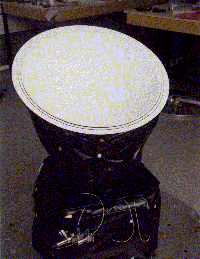
IMAGE - The EPIC Camera as shown on the Design and Instrumentation page but with MLI blankets included.
One of the places where the control of heat flows in XMM is of particular importance is the cooling systems for the detector CCDs. Generally, the problems of cooling specific detectors on spacecraft is that not only does the internally generated heat of the detector have to be radiated away but also the parasitic power which consequently comes into the cooled device from its now warmer surroundings. This parasitic power is radiated in from the warm surrounding surfaces and conducted in along the electrical wires to the detector itself.
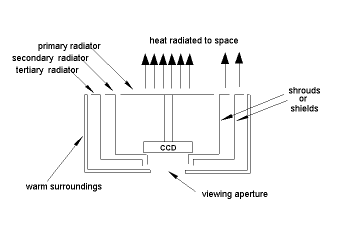
IMAGE - A representation of a multistage radiator
The multistage radiator works on the principle of intercepting the warm radiation from the surroundings by means of shrouds which enclose the detector and conducting the heat along the shrouds to the outside of the spacecraft where it can be dumped to space directly with a radiator which is dedicated to that particular shroud. The principle can be repeated in a nest of such shrouds and radiators surrounding the detector. By dividing up the total available radiating area in this way a more efficient use is made of this area*. Use Stefan's law to show mathematically that this is the case. Please click here for help.
*[This is so because the rate at which heat can be
radiated from a surface is proportional to the 4th power of its
temperature and not simply to its temperature.
Stefan's law is P=![]() AT4 where P is the
power, A is the surface area, T is the temperature and ( is the
constant of proportionality and is called Stefan's constant
(
AT4 where P is the
power, A is the surface area, T is the temperature and ( is the
constant of proportionality and is called Stefan's constant
(![]() = 5.7x10-8
Wm-2K-4 ).]
= 5.7x10-8
Wm-2K-4 ).]
![]()
Are circulating, heat transfer systems ever used in spacecraft?
In general it is best to avoid the use of fluids and gases to transport heat because these systems have to be sealed. If they are ruptured they not only become ineffective but can be dangerous in that the released fluids/gases can contaminate other parts of the system causing them to malfunction.
However, because such systems are very effective and because they can be 'routed' they have been used, particularly in manned missions where the temperature control is more critical.
An important example of such a system which is quite widely used is the heat pipe.

